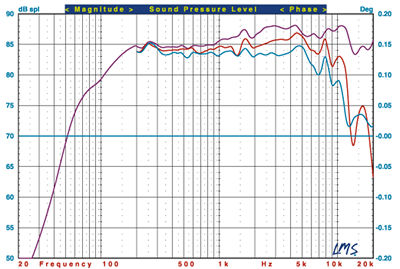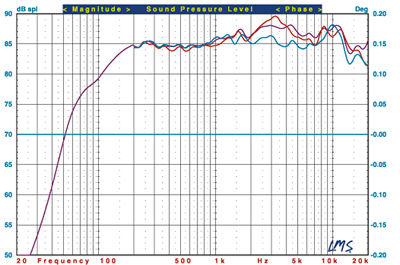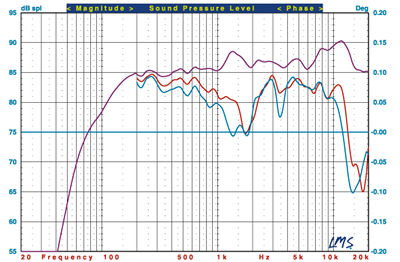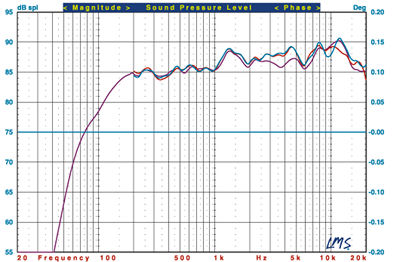Energy Take 5.2 surround speaker system Measurements
The Energy Take 2.2's sensitivity is approximately 85dB/W/m across the midrange. Its ported cabinet is tuned to 80Hz, and I would rate its nominal impedance at 6ohms. The speaker's minimum impedance is 4.1ohms at 380Hz; it should be a relatively easy load to drive.
The pseudo-anechoic response of the Take 2.2 at tweeter height, averaged over a 30° forward horizontal angle and combined with the nearfield responses of the woofers and port, is shown in Fig.1 (violet). The useful bass extends down to approximately 62Hz (-10dB relative to the output through the midrange). The on-axis average is smooth through the midrange, but is elevated by 2-3dB across the treble, suggesting a slightly bright response. SW did not find this to be a problem. The off-axis performance is also quite smooth up to about 5kHz, where it begins the slow response rolloff common to most speakers.

Fig.1: Energy Take 2.2, pseudo-anechoic horizontal response at 45° (red) and 60° (blue) relative to tweeter axis.
Fig.2 shows the vertical off-axis response of the Take 2.2. The average on-axis and off-axis curves are quite similar, but show that the smoothest overall response occurs slightly below the tweeter. This suggests that, in many installations, a high stand (such as the Energy stand SW used) will provide the best performance.

Fig.2: Energy Take 2.2, pseudo-anechoic vertical response at +15° (red) and -15° (blue) relative to tweeter axis.
The cabinet of the Take 1.2 center-channel speaker is tuned to 87Hz. I would rate its nominal impedance at 10ohms; its minimum impedance of 7.3ohms occurs at 1.5kHz. The 1.2 should be an even easier load to drive than the 2.2. Its sensitivity measured approximately 85dB/W/m through the midrange, and its useful bass response extended down to about 74Hz (-10dB).
The Take 1.2's measured front horizontal response, taken on the tweeter axis and averaged in the same manner as described above for the Take 2.2, is shown in Fig.3 (violet). The response is similar, but with slightly more treble emphasis above 10kHz. The off-axis response exhibits the same sort of response dip we see in virtually all horizontally configured, woofer-tweeter-woofer center-channel speakers, here just below 2kHz. But the Take 1.2 is small enough that it would not be impractical to position it vertically atop most televisions, where it will provide far better lateral off-axis performance (for the best results it should also be tilted down toward the listeners' ears). This can be seen in Fig.4, which shows the vertical response of the Take 1.2 in its normal, horizontal configuration. But turn the speaker on its side, and the vertical response of Fig.4 becomes the horizontal response.

Fig.3: Energy Take 1.2, pseudo-anechoic horizontal response at 45° (red) and 60° (blue) relative to tweeter axis.

Fig.4: Energy Take 1.2, pseudo-anechoic vertical response at +15° (red) and -15° (blue) relative to tweeter axis. All figures: Violet: Pseudo-anechoic response on tweeter axis, averaged across a 30° horizontal window, combined with nearfield woofer and port responses.
This is a very respectable set of measurements for a speaker in this price range, with a smooth if slightly bright balance and an impedance characteristic that should be easy for any competent amplifier or receiver to drive.—Thomas J. Norton
- Log in or register to post comments





























































